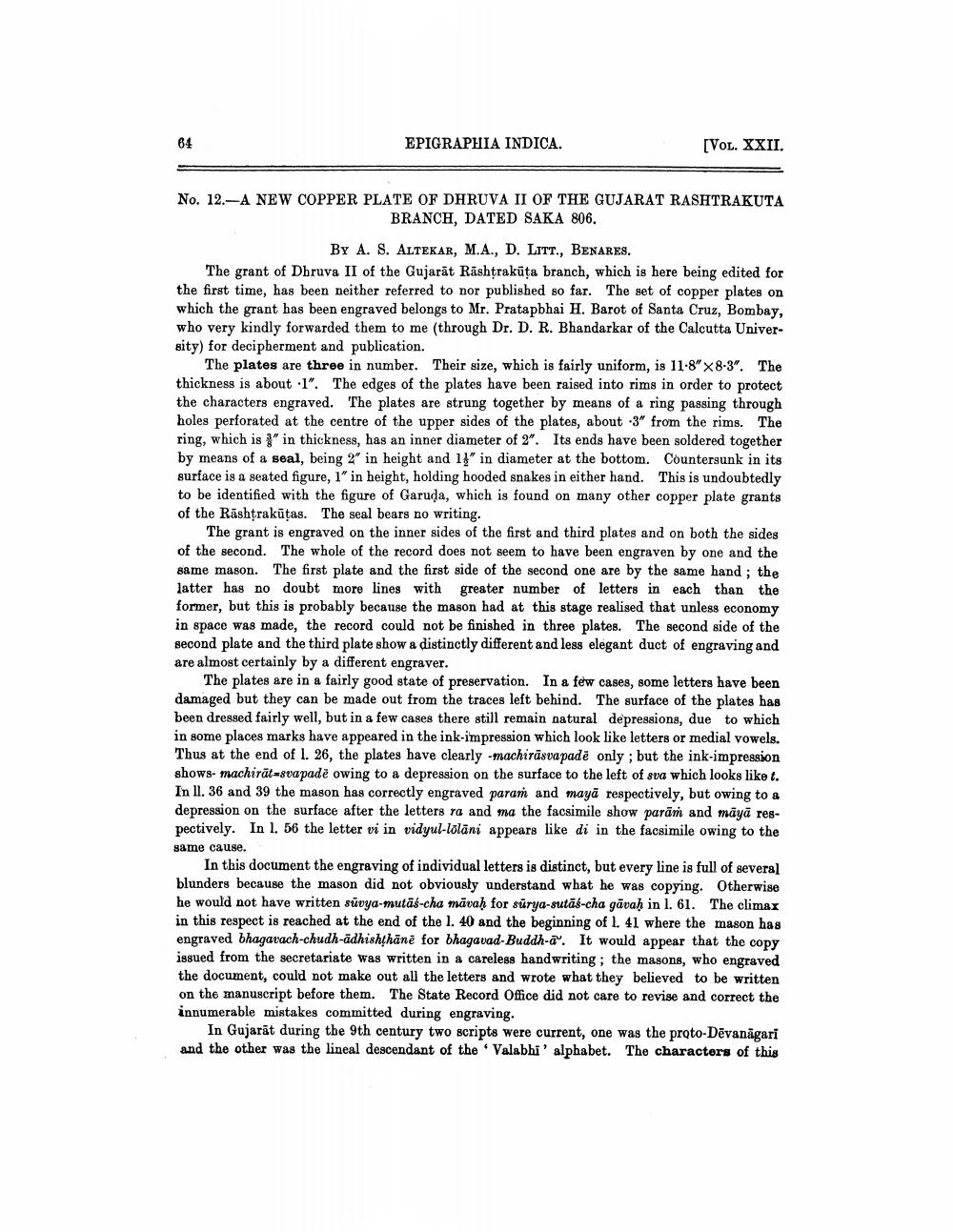________________
EPIGRAPHIA INDICA.
[VOL. XXII.
No. 12.-A NEW COPPER PLATE OF DHRUVA II OF THE GUJARAT RASHTRAKUTA
BRANCH, DATED SAKA 806.
By A. S. ALTEKAR, M.A., D. LITT., BENARES. The grant of Dhruva II of the Gujarāt Rashtrakūta branch, which is here being edited for the first time, has been neither referred to nor published so far. The set of copper plates on which the grant has been engraved belongs to Mr. Pratapbhai H. Barot of Santa Cruz, Bombay, who very kindly forwarded them to me (through Dr. D. R. Bhandarkar of the Calcutta University) for decipherment and publication.
The plates are three in number. Their size, which is fairly uniform, is 11.8" X 8.3". The thickness is about .1". The edges of the plates have been raised into rims in order to protect the characters engraved. The plates are strung together by means of a ring passing through holes perforated at the centre of the upper sides of the plates, about 3" from the rims. The ring, which is " in thickness, has an inner diameter of 2". Its ends have been soldered together by means of a seal, being 2" in height and 1" in diameter at the bottom. Countersunk in its surface is a seated figure, 1" in height, holding hooded snakes in either hand. This is undoubtedly to be identified with the figure of Garuda, which is found on many other copper plate grants of the Rashtrakūtas. The seal bears no writing.
The grant is engraved on the inner sides of the first and third plates and on both the sides of the second. The whole of the record does not seem to have been engraven by one and the same mason. The first plate and the first side of the second one are by the same hand; the latter has no doubt more lines with greater number of letters in each than the former, but this is probably because the mason had at this stage realised that unless economy in space was made, the record could not be finished in three plates. The second side of the second plate and the third plate show a distinctly different and less elegant duct of engraving and are almost certainly by a different engraver.
The plates are in a fairly good state of preservation. In a few cases, some letters have been damaged but they can be made out from the traces left behind. The surface of the plates has been dressed fairly well, but in a few cases there still remain natural depressions, due to which in some places marks have appeared in the ink-impression which look like letters or medial vowels. Thus at the end of l. 26, the plates have clearly-machirāsvapadě only; but the ink-impression shows- machirät-svapade owing to a depression on the surface to the left of sva which looks like t. In II. 36 and 39 the mason has correctly engraved param and mayā respectively, but owing to & depression on the surface after the letters ra and ma the facsimile show parāṁ and māyā respectively. In l. 56 the letter vi in vidyul-lölāni appears like di in the facsimile owing to the same cause.
In this document the engraving of individual letters is distinct, but every line is full of several blunders because the mason did not obviously understand what he was copying. Otherwise he would not have written sūvya-mutās-cha mavah for surya-sutās-cha gāvah in l. 61. The climax in this respect is reached at the end of the 1. 40 and the beginning of 1. 41 where the mason has engraved bhagavach-chudh-ādhishthäne for bhagavad-Buddh-a'. It would appear that the copy issued from the secretariate was written in a careless handwriting; the masons, who engraved the document, could not make out all the letters and wrote what they believed to be written on the manuscript before them. The State Record Office did not care to revise and correct the innumerable mistakes committed during engraving.
In Gujarāt during the 9th century two scripts were current, one was the proto-Dēvanāgari and the other was the lineal descendant of the Valabhi' alphabet. The characters of this




